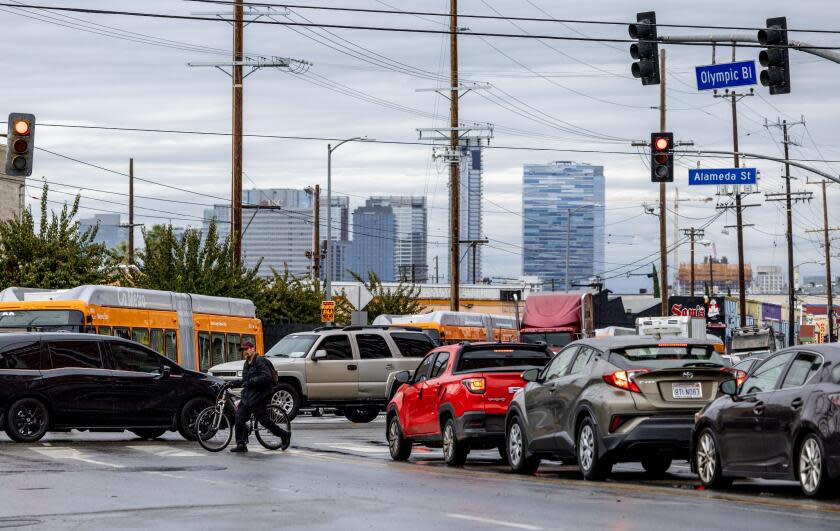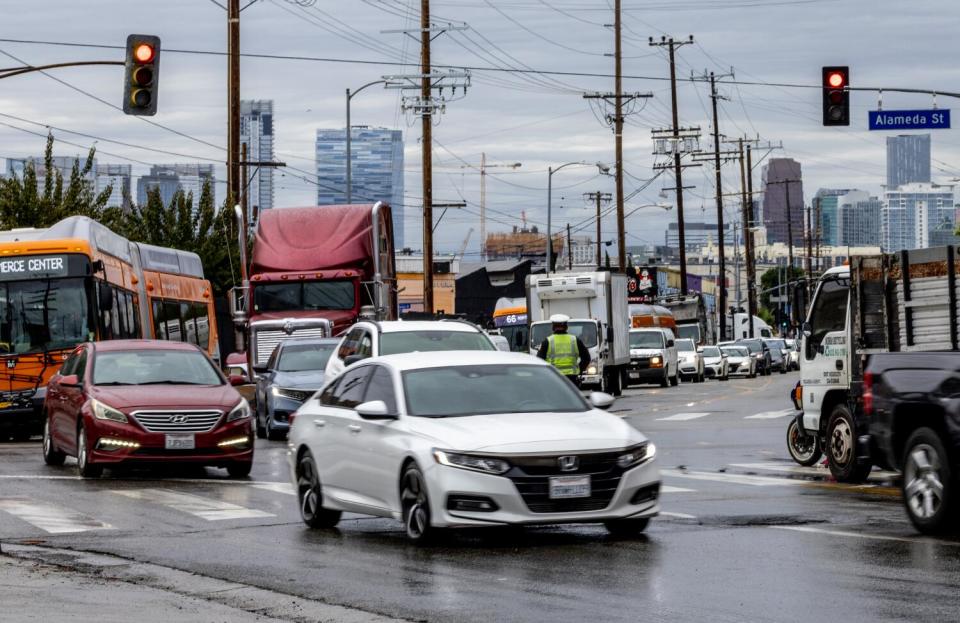'You can smell the pollution': 10 Freeway closure brings traffic, fumes, anger for residents

- Oops!Something went wrong.Please try again later.
Four days after a massive fire erupted under the 10 Freeway in downtown Los Angeles, shutting down one of the country's busiest commuting corridors, morning traffic rumbled through the intersection of Whittier Boulevard and Soto Street.
Cars and trucks that would ordinarily take the freeway were winding their way Wednesday through Boyle Heights, where 78-year-old Tony Zapata sat with his friends inside Big Jim's Donuts.
“Especially in the mornings and evenings with people coming to work and getting off work, the traffic is terrible,” said Zapata, who has lived in the neighborhood for 36 years.
From inside the shop, Zapata watched a semitrailer truck slowly turn and block the road. With all the trucks in the area, he said it feels like more vehicle exhaust is lingering in the air.
“You can smell the pollution,” he said. “You can feel it. It’s all over.”
Read more: Under the 10 Freeway: Immigrant businesses scraped by while landlord dodged Caltrans
While arson investigators search for answers about the fire that damaged the overpass at Alameda Street, the roughly 300,000 commuters who drove on that stretch of the 10 daily must find alternative routes.
The closure has not caused widespread gridlock across L.A.'s freeway system, but it's become a nightmare of traffic, noise and pollution for residents who live nearby and whose neighborhoods have become detour shortcuts.
“It seems like every day there’s more and more of them,” Zapata said, shaking his head.
On Monday, traffic on downtown streets increased by 15% over the normal daily amount — that shot up to 26% above normal Tuesday, according to Laura Rubio-Cornejo, general manager of the Los Angeles Department of Transportation.
Read more: Rain falls across California as thunderstorm threat grows. More storms forecast into weekend
And this week's rains are expected to add new levels of pain.
Mayor Karen Bass urged commuters to use the other freeways around downtown and stay off local streets that are becoming increasingly congested.
“The surface streets look like an absolute parking lot,” Bass said.

The traffic made it almost impossible for Guadalupe Hernandez to walk her 9-year-old daughter across the street to Soto Street Elementary School on Wednesday morning, she said.
“It’s just terrible,” said Hernandez, 34, raising her voice as trucks roared past the makeshift stand where she sells hats and bracelets at Whittier and Soto streets. “It’s not safe for my daughter.”
Although there was someone in front of the campus to direct traffic, Hernandez said it was still difficult to get her daughter to school.
“The car accidents and road rage on that street … something needs to be done about it,” she said.
After a morning delivery in Lincoln Heights, truck driver Freddy Ramirez, 44, pulled to the side of Daly Street to navigate to his next stop, which was right by the freeway closure.
“I have to figure out how to get through there,” Ramirez, who works for grocery hauler F & W Food Services, said over the roar of his truck engine as he leaned out the window before taking off.
Read more: Section of 10 Freeway damaged by fire will not need to be demolished, officials say
As commuters and neighbors grapple with the shutdown, it appears initial fears of a potentially months-long traffic nightmare will be avoided.
Tests of core samples taken from the damaged freeway overpass showed it will not require a total teardown, Gov. Gavin Newsom said Tuesday.
In a virtual meeting Tuesday afternoon, senior engineers and other Caltrans officials concluded that the 10 could be safe to open to full capacity early next week as soon as shoring is raised and the barrier rail and night lighting are repaired.
“Monday or Tuesday if everything goes well,” said one of the engineers, who was not authorized to speak publicly and requested anonymity. “Just in time for the Thanksgiving holiday.”
Having tested the compression strength of the concrete, the engineers are confident that the freeway can support normal traffic loads. With crews still working to clear debris from under the freeway, the wooden structure that will support the roadbed around the damaged columns is already being constructed.
“We went from a worst-case scenario — demolishing and rebuilding, which was on the table for a while — to a situation where it is just a repair and we’re done,” said the engineer.
Though the repairs are not expected to affect traffic on the freeway once it reopens, the work will be extensive. Engineers have identified 45 columns that need to be rebuilt.
Read more: 10 Freeway damage not as severe as expected, engineer says, but more tests are needed
In the coming weeks, crews will remove up to four inches of concrete from the outside of each column. They will replace the embedded steel ties that surround the reinforcing steel rods, or rebar, inside the concrete, and then they will resurface the column with a new layer of concrete.
“It will take a while just because there are so many columns,” said the engineer, who estimated the repairs would take at least two months.
Though the total cost of the freeway repairs has not been revealed, the project has secured $3 million in "quick release" federal emergency funds, Caltrans announced Wednesday.
In the months ahead, investigators are hoping to identify what was stored under the freeway in an apparent violation of a Caltrans policy put in place after combustible materials stored under Interstate 85 caught fire in 2017 and caused a portion of the highway in Atlanta to collapse.
“It all has to do with what was under that bridge, how long it was there and who knew about it,” said the Caltrans engineer. “We should not have been in this situation. It was completely avoidable.”
As rain moved across Southern California on Wednesday, officials renewed their pleas for commuters to avoid driving into downtown if possible or use public transportation. Transit ridership was up 10% on Tuesday compared to the daily average; on Wednesday, Bass rode a Metro train into downtown and encouraged others to do the same.
Read more: L.A.'s post-fire push for public transportation: Free rides, faster trains, more buses
A closure of this magnitude will inevitably have ripple effects that spread out to surface streets and neighborhoods along the detour route, said UCLA professor Michael Manville, chair of urban planning.
Predicting how commuters will react is nearly impossible.
"Keep in mind with everything, you're talking about millions of individual decisions by millions of travelers," Manville said.
Some commuters who turn to public transportation as an alternative might decide to stick with it after several weeks. Others will detour in their cars but find traffic congestion on surface streets, and there are still more people who will carpool.
The question remains whether people will jump back on the freeway after repairs are done or turn to public transportation on a more regular basis.
That might seem like a silver lining for train and bus services that have seen declining ridership compared to the pre-pandemic era. But a massive fire shouldn't be the way to get more people onto public transit, Manville said.
"From a broader perspective of social welfare, it's hard to rejoice at the destruction or temporary destruction of a piece of infrastructure that a lot of people rely on every day," he said.
Los Angeles, after all, is set up around freeways and moving cars on said freeways.
"Even when they're congested, they're often the fastest way to go for trips of any reasonable length," Manville said. "It's entirely possible that for the typical traveler who was on the 10 at rush hour in the morning, whatever adaptation they make during this closure is really going to be inferior to being on the 10."
This story originally appeared in Los Angeles Times.

